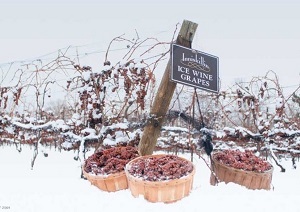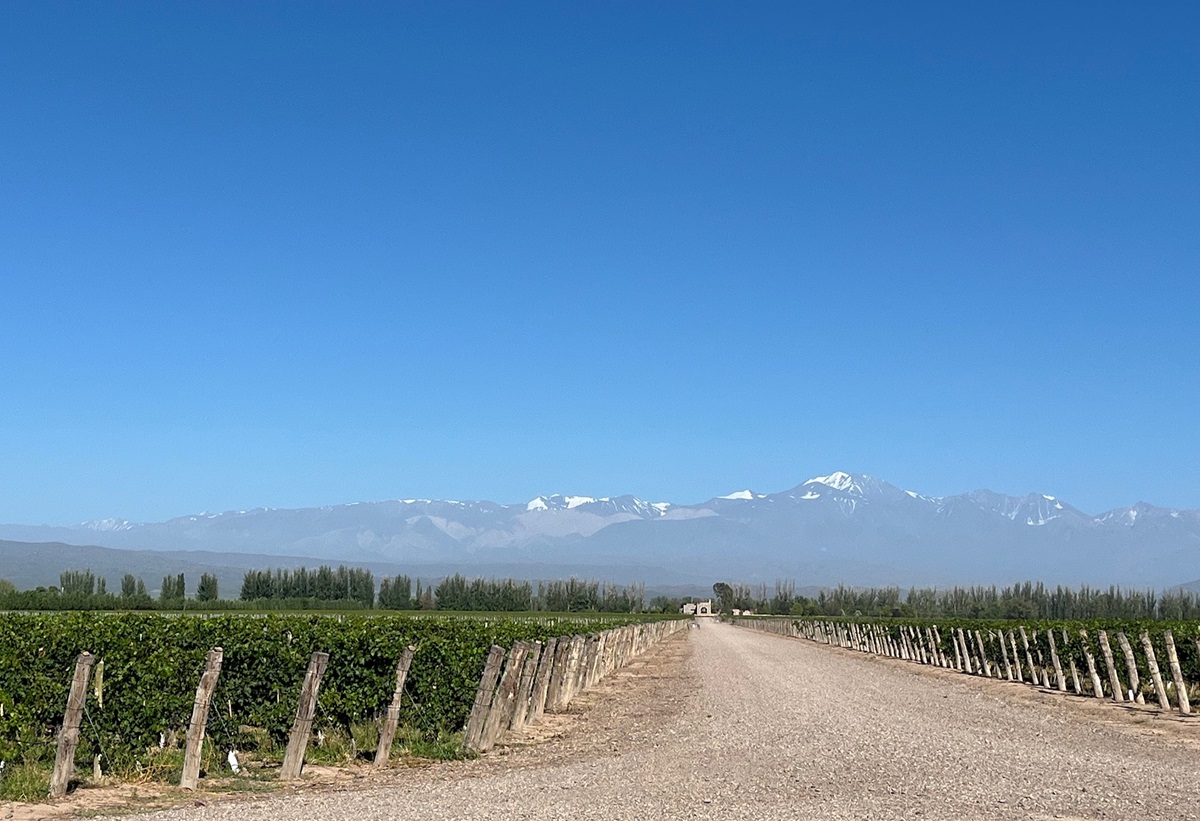THE FROZEN GRAPE: ICE WINE TASTING

By Rose Murray Brown MW Published in The Scotsman 3 June 2017
One of the hardest tasks in the wine world is the Ice Wine harvest. In the dead of night in December or January, with temperatures well below -8 degrees C, teams of pickers work through the night in vineyards harvesting and pressing frozen berries. The result is one of the most intense dessert wines in the world – but it is a labour of love.
 “What people do not realise is that Ice Wine production always means a financial loss, certainly now in Europe”, says Eckart Waitz of Hans Lang estate in Germany’s Rheingau. “In the past the magic low temperatures -8 C or below were more common and harvests earlier, now they are few and far between – many wineries don’t produce Ice wine anymore due to the risk of loosing all their grapes”, says Waitz.
“What people do not realise is that Ice Wine production always means a financial loss, certainly now in Europe”, says Eckart Waitz of Hans Lang estate in Germany’s Rheingau. “In the past the magic low temperatures -8 C or below were more common and harvests earlier, now they are few and far between – many wineries don’t produce Ice wine anymore due to the risk of loosing all their grapes”, says Waitz.
In a good year Germany can make 120,000 bts of Eiswein and in Austria, Switzerland, Slovenia, Hungary, Moldova and Georgia tiny amounts are made when temperatures permit – but due to rising temperatures European Ice Wine is becoming scarce.
The one country in the world today with a regular supply is Canada (where it is labelled ‘Icewine’), consistently cold enough to produce 1-2 million half bottles annually, with 75% from Ontario.
There is also an interesting newcomer in the market, China. Up in Liaoning province in northeast China near Russian and North Korean borders, conditions are similar to Ontario. Here Canadian consultants advise Chinese wineries – with Vidal grape the most successful.
 The hardy hybrid grape Vidal has been Canada’s popular choice since early 1970s when Canadian Icewine was first made. Growers chose aromatic fruity grapes like Riesling or Gruner Veltliner, but some experiment with red varieties, with a demand for sweet red wines in Asia, like Cabernet Franc, Pinot Noir, Zweigelt and even Syrah.
The hardy hybrid grape Vidal has been Canada’s popular choice since early 1970s when Canadian Icewine was first made. Growers chose aromatic fruity grapes like Riesling or Gruner Veltliner, but some experiment with red varieties, with a demand for sweet red wines in Asia, like Cabernet Franc, Pinot Noir, Zweigelt and even Syrah.
To make Ice Wine, healthy ripe grapes must have no ‘botrytis’ noble rot – and this is where it differs from Sauternes. As grapes are left on the vine through winter, deer, wild boar and birds are attracted to the juicy sweet grapes (nets are essential) or disease, rain, wind or hail can devastate crops.
Yet the hardest part is handpicking 2am – 6am, then pressing the frozen pellets of grapes, often as hard as marbles, before they thaw. Natural freezing conditions concentrate the sugar, acidity and extract – and water in grapes is left behind as ice crystals in the press – resulting in tiny yielsd of intensely sweet juice which ferments very slowly.
 Tastewise, Ice Wine is intensely sweet – particularly Canadian ‘icewine’ which is picked at a higher sugar level – but it always has a freshness from enhanced acidity – and it is never cloying or too high in alcohol. Many think Ice Wine should be enjoyed when vibrant, fresh and young. Despite the high sweetness levels, Ice Wine can be a sommelier’s dream matching well alongside blue cheeses or desserts like mango sorbet and crème brulee.
Tastewise, Ice Wine is intensely sweet – particularly Canadian ‘icewine’ which is picked at a higher sugar level – but it always has a freshness from enhanced acidity – and it is never cloying or too high in alcohol. Many think Ice Wine should be enjoyed when vibrant, fresh and young. Despite the high sweetness levels, Ice Wine can be a sommelier’s dream matching well alongside blue cheeses or desserts like mango sorbet and crème brulee.
In our tasting, we compared Ice Wines from five countries: Canada, Switzerland, Austria, Germany and China:
GERMANY
Rheingau: WINKELER GUTENBERG RIESLING EISWEIN 2012 Allendorf
(6.5%; £25.15 hf bt www.thewinebarn.co.uk)
Light floral style from Fritz Allendorf, an old wine growing family domaine in Winkel where deep chalky soils give delicate wines with finesse and elegance.
 Franken: IPHOFER KRONSBERG RIESLING EISWEIN 2002 Hans Wirsching
Franken: IPHOFER KRONSBERG RIESLING EISWEIN 2002 Hans Wirsching
(10%; £52.50 hf bt www.thewinebarn.co.uk)
***STAR BUY***
Star winemaker Hans Wirsching owns Kronsberg vineyard site in Iphofen, where oak forests shield steep slopes to the north and east. Floral notes, intense apricot and caramel fruits, beautifully poised and still fresh despite age; bottled in traditional Bocksbeutel.
Rheingau: HATTENHEIMER SCHUTZENHAUS RIESLING EISWEIN 2010 Hans Lang (6.5%; £45 hf bt Waitrose)
***STAR BUY***
Superb effort from Hans Lang estate, now owned by Swiss cheese entrepreneur Urban Kaufmann: poised fruits, vibrant grapefruit acidity and balancing sweetness.
AUSTRIA
Traisental: RIESLING EISWEIN 2015 Markus Huber (8.5%; £28 hf bt Oddbins)
Floral bouquet with caramel and vanilla flavours and a fresh vibrant acidity. Made by up-and-coming winemaker Markus Huber southwest of Vienna, with grapes picked on New Year’s Eve at -11 degrees.
 Burgenland: ZWEIGELT EISWEIN 2009 Nittnaus (11.5%; £25 hf bt www.alpinewines.co.uk)
Burgenland: ZWEIGELT EISWEIN 2009 Nittnaus (11.5%; £25 hf bt www.alpinewines.co.uk)
Pale rose with light strawberry and cranberry hints. An unusual effort from the eastern shore of Lake Neusiedl in Gols in southern Austria.
SWITZERLAND
Valais: EYHOLZER ROTER ‘CRYSTAL’ EISWEIN 2008 Josef-Marie Chanton (10.6%; £64.66 hf bt www.alpinewines.co.uk)
***STAR BUY***
Eyholzer Roter grape is as rare as hen’s teeth wite 0.25 hectares worldwide. The Chantons specialize in rare Valais grapes in western Switzerland, harvesting from Europe’s highest altitude vineyards at 1100m. Rich intense sweetness balanced with grapefruit and caramel hints – a deliciously decadent treat.
CANADA
Niagara: GOLD VIDAL ICEWINE 2014 Inniskillen
(9.5%; £52-£53 hf bt Fine Wine Co; Raeburn Wines)
Like a liquid lemon meringue pie with zippy fresh grapefruit hints, made by Canada’s best known Icewine producers, Inniskillen, founded originally by German immigrant Karl Kaiser in 1974.
 Kingsville: VIDAL ICEWINE 2008 Pelee Island (9.5%; £39 hf bt www.greatwinesdirect.co.uk)
Kingsville: VIDAL ICEWINE 2008 Pelee Island (9.5%; £39 hf bt www.greatwinesdirect.co.uk)
***STAR BUY***
Best balanced Vidal in our tasting, with pineapple and mango fruits, luscious sweet palate and length. From one of Ontario’s oldest vineyards on Pelee island, in western Lake Erie, Canada’s warmest and most southernmost vineyard area.
Niagara: CABERNET FRANC ICEWINE 2013 Peller Estate (11.5%; £45 hf bt Morrisons, Luvians, Cupar; Great Western Wine; www.winedirect.co.uk)
The Pellers first set up in Okanagan Valley in British Columbia, moving to Ontario in 1969. An unusual icewine with pale pink, raspberry flavours, hints of tannin and spice.
CHINA
Liaoning: GOLDEN LABEL VIDAL ICE WINE 2009 Changyu
(11%; £19 hf bt Berry Bros & Rudd www.bbr.com)
Made by China’s largest company, Changyu, around Hualong Lake with Canada’s Aurora. The lightest of Changyu’s wines with limey freshness and succulent sweetness shows potential.
Join Rose’s Spain v Portugal wine & charcuterie tasting in The Scores Hotel, St Andrews Friday 9 June £35 www.rosemurraybrown.com
wine tastings
The perfect gift for the wine enthusiast in the family. Rose does In-person tastings too.
cellar advice
Rose does cellar valuations for private clients, valuations for insurers & bespoke portfolio management.
Related stories
March 31, 2024
By Rose Murray Brown MW Published in The Scotsman 30 March 2024 On 2 February 1659, the first wine made from grapes grown in South Africa was crafted by the Governor of the Cape, Jan van Riebeeck. He had planted vines four years earlier in the Company’s Garden near Cape Town from cuttings imported from France. Van Riebeeck’s first
March 24, 2024
By Rose Murray Brown MW Published in The Scotsman 16 March 2024 Heatwaves and bushfires were very much on the agenda when I visited Chile last month as winemakers prepared for their 2024 harvest in blistering heat and drought, with a plume of smoke from the devastating fires lingering over coastal hills. Heat and drought are the greatest challenges
March 23, 2024
By Rose Murray Brown MW Published in The Scotsman 9 March 2024 I have two glasses of Malbec in my hands from the same high-altitude vineyard in Uco valley in Argentina. I am in the Catena Institute of Wine in Mendoza with winemaker Agustin Silva. He has asked me to taste the two wines, both from the 1500m high



